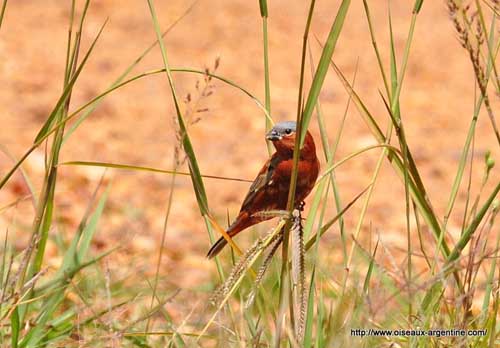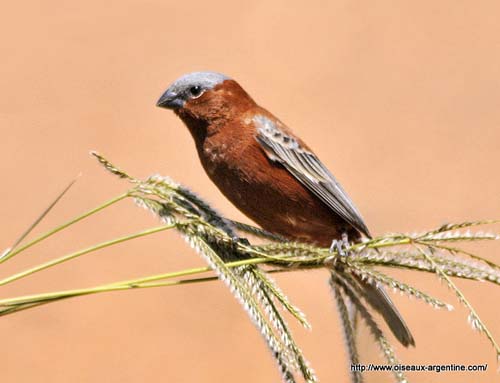
Fr: Sporophile cannelle
All : Zimtpfäffchen
Esp : Espiguero de Corona Gris
Ital : Beccasemi castano
Nd: Kaneeldikbekje
Sd: Kastanjebrun frösparv
Port: Caboclinho-de-chapéu-cinzento
Photographers:
Philippe and Aline Wolfer
OISEAUX D'ARGENTINE
Text by Nicole Bouglouan
Sources:
HANDBOOK OF THE BIRDS OF THE WORLD Vol 16 by Josep del Hoyo- Andrew Elliot-David Christie – Lynx Edicions – ISBN: 9788496553781
BIRDS OF SOUTH AMERICA – Passerines - by Robert S. Ridgely and Guy Tudor – HELM Field Guides – ISBN: 9781408113424
BirdLife International (BirdLife International)
Chestnut Seedeater
Sporophila cinnamomea
Passeriforme Order – Thraupidae Family
BIOMETRICS:
Length : 10 cm
DESCRIPTION:
The Chestnut Seedeater is a handsome bird of Thraupidae family. This species is threatened by heavy trapping and changes in its habitat. It is a rare and local breeder, but in suitable conditions, they may occur in large numbers.
The adult male has mostly chestnut body and head, contrasting with the grey crown. Wings and tail are slate-grey to blackish. There is a white wing patch at base of primaries.
Some males may have pale-tipped feathers on the underparts, giving less uniform appearance.
The stout bill is black. The eyes are dark brown. Legs and feet are black.
The female is much duller, with warm sandy-brown upperparts with darker wings and tail. The wing-coverts are edged sandy-brown. The underparts are buff with whitish belly. Throat and breast can be sometimes whitish on middle too.
The bill is dark brown to blackish. Legs and feet are blackish.
The juvenile resembles female. The young male becomes later darker above and buffer below. Dark feathers may appear on the upperparts.
VOICE: SOUNDS BY XENO-CANTO
The Chestnut Seedeater’s call is a sweet descending whistle “tweeeeww”
The song is sweet and melodious, and includes several similar whistles interspersed with some more nasal or warbled notes “tweew tii-tweeew tweeew, peew put-tweew…”

HABITAT:
The Chestnut Seedeater breeds in seasonally flooded grasslands in a limited area of NE Argentina and Uruguay, during austral spring and summer.
This species migrates during the austral winter to campos and grassy Cerrado of SW Brazil where it favours wet areas with tall grass. It is visible up to 1100 metres of elevation.
RANGE:
The Chestnut Seedeater is found in NE Argentina, extreme SE Paraguay, extreme SE Brazil, and W and SE Uruguay.
It migrates N as far as SC Brazil.
BEHAVIOUR:
The Chestnut Seedeater feeds on grass seeds and does not consume other food. It clings to the grass stem to reach the seeds and takes them. They usually forage in small groups, and sometimes join other seedeater species.
Outside the breeding season, they occur in larger flocks with other species of the same genus.
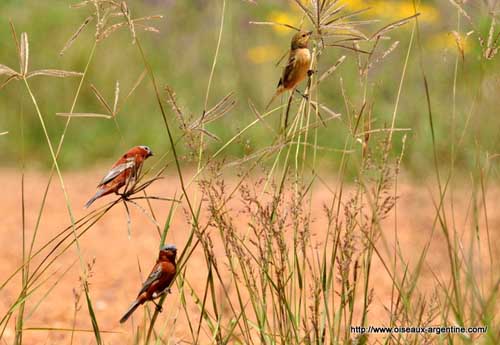
Breeding activities start with the heavy rains in November/December. The male is territorial and defends its area. It usually stays close to the female during the laying period and performs mate-guarding.
During the breeding season, the male often sings at night. It usually sings from exposed perch, while fluffing its plumage with raised head and bill pointed upwards.
During this period, fights may occur between males. The owner chases rivals away from its territory.
The species is probably mainly monogamous, although they may mate with other partners in high density populations. But once the eggs are laid, birth mates remain together.
FLIGHT:
The Chestnut Seedeater performs direct or slightly undulating long-distance flight.
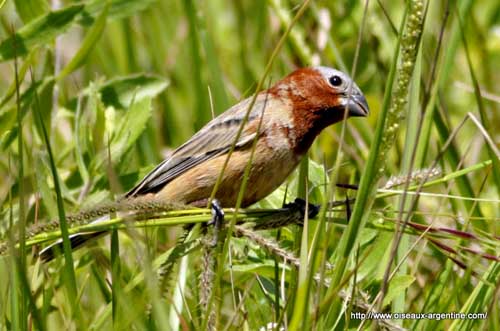
REPRODUCTION:
The breeding season occurs between December and February.
The Chestnut Seedeater’s nest is a cup made with woven dry grass and rootlets, and usually pale in colour for better camouflage in tall grass or shrub. This structure is lined with animal hair and spider webs, and is built by the female.
She lays 2-3 white eggs with dark markings. She incubates alone during 12-13 days. Only the female develops an incubation patch and incubates. The male may sometimes bring her some food at nest.
The chicks are fed by both parents with insects and larvae. They still depend on adults for about one month. They are able to fly two weeks after hatching.
This species may produces 2-3 clutches per season.
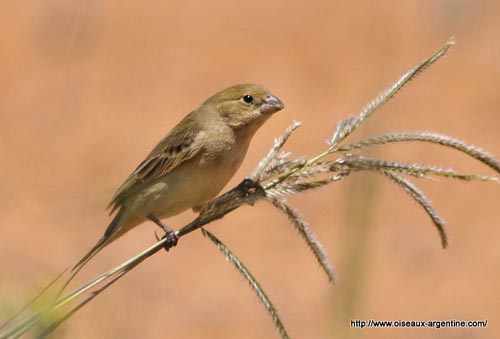
DIET:
The Chestnut Seedeater feeds on seed grass, but the chicks are fed with insects and larvae during the nesting period.
PROTECTION / THREATS / STATUS:
The Chestnut Seedeater is qualified as Vulnerable, due to rapid population decline. This species is threatened by heavy illegal trapping for cagebird trade. But degradation and habitat loss with drainage of wetlands, overgrazing and exotic plantations affect these birds too.
In addition, the use of pesticides and other chemicals which enter marshes, invasive grasses and regular burning threaten the non-breeding grounds.
However, the Chestnut Seedeater is protected in several parts of its range, where trapping is prohibited, but illegal trade continues!
Currently, the Chestnut Seedeater is qualified as VULNERABLE.
